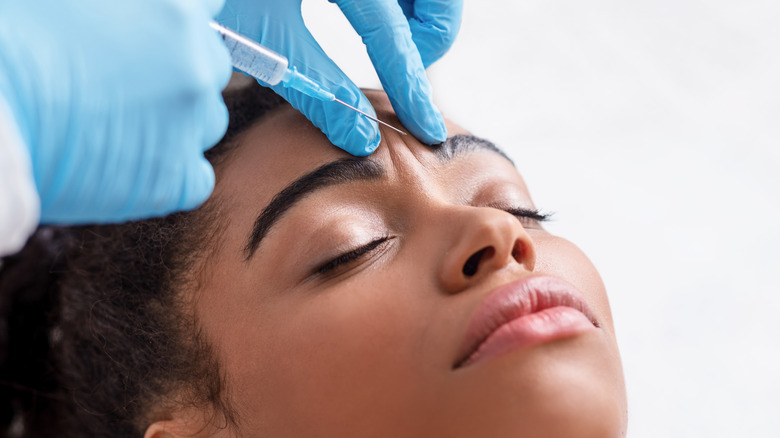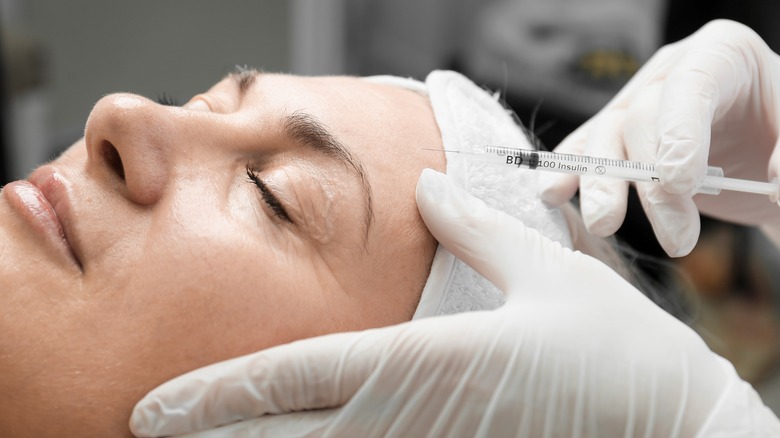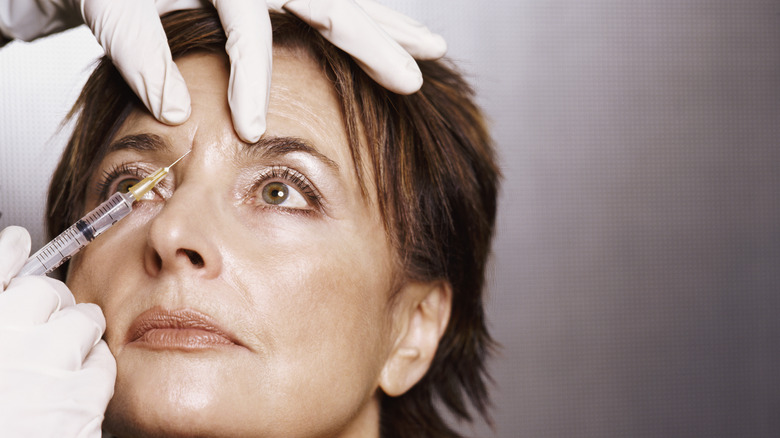What's The Difference Between Botox And Jeuveau?
If you're looking for an anti-wrinkle injection and trying to decide which one is right for you, here's the scoop on the difference between popular options Botox and Jeuveau. They are different in many ways, but also share several similarities, per GoodRx Health. Not only are both administered in the same method — via injection by trained practitioners — but they work in similar ways to decrease the appearance of fine lines and wrinkles. The injected solutions work to block nerves, thus restricting muscle contractions in the surrounding area and reducing facial movements that can lead to skin creases. Both Botox and Jeuveau are effective at keeping wrinkles at bay, both new and existing.
The differences between Jeuveau and Botox are nuanced and often more practical than functional since both injectables work in very similar ways (via Plastic Surgery Services). Sometimes, the option you choose may come down to cost if one is drastically cheaper than the other. Other times, your choice may be based on which one your body responds best to or if you happen to have an allergic reaction to a specific solution. To prevent potential reactions, your practitioner should test the solution on a small portion of skin if it's your first time getting an anti-wrinkle treatment. Otherwise, both Botox and Jeuveau have safe track records and contain many of the same ingredients, making the differences between them minute. For those who aren't trained experts in these solutions, here are the differences between Botox and Jeuveau.
Botox can treat a greater variety of conditions
Botulinum toxin type A, popularly known simply as Botox, is an injectable solution derived from bacterium Clostridium botulinum, according to MedlinePlus. When applied in small doses, the solution can restrict muscle movement, therefore smoothing skin, for a temporary amount of time to decrease the cosmetic appearance of wrinkles and prevent new fine lines from being created. Between Jeuveau and Botox, the latter is FDA approved to treat a greater number of medical conditions, which makes it more accessible and able to be covered by health insurance in many instances (per Plastic Surgery Services). The conditions that Botox is commonly used to treat include migraines, uncontrollable blinking (blepharospasm), excessive sweating in the underarms and palms of hands, overactive bladder, and a neurological condition called cervical dystonia, which results in intense contractions of the shoulder and neck muscles.
When it comes to Botox for cosmetic use, it's important to know that the only FDA approved use of Botox for cosmetic purposes is treating moderate to severe forehead lines, frown lines, and crow's feet around the eyes. For Botox to fully take effect, you'll have to wait approximately 24 to 72 hours after the injections are administered, during which time you'll want to avoid exercise and exposure to warm temperatures, including hot showers. The results of Botox injections typically last between three months and a full year depending on the specific treatment you receive.
Jeuveau is newer on the market
You may also hear Jeuveau called Newtox in a play on words for Jeuveau being a newer version of wrinkle-reducing injectable similar to Botox, per Healthline. Jeuveau is also a solution of Botulinum toxin A and received FDA approval for wrinkle treatments in 2019, compared to Botox's initial FDA approval in 2002. Like Botox, Jeuveau is used cosmetically to reduce fine lines and wrinkles around the eyes, on the forehead, at the corners of the mouth, and between the eyebrows. Jeuveau has a slightly different formula than Botox solution contains, which some people may respond better to. However, to discern the better solution for you, it may be left up to trial and error in trying both solutions to see which one you prefer. To see the full results of Jeuveau taking effect, you'll have to wait up to seven days, so if you're impatient, then the three days to see the effects of Botox may be the better option for you.


